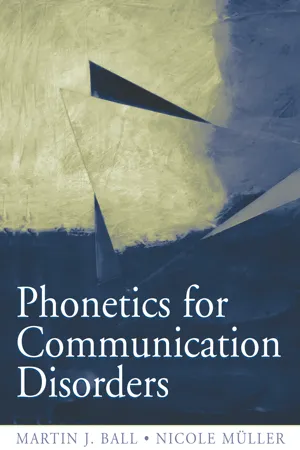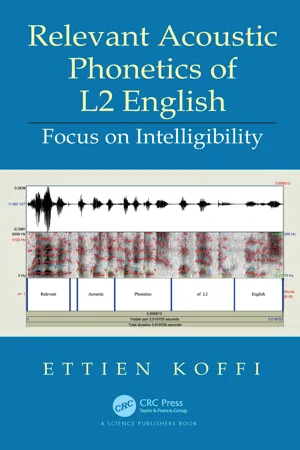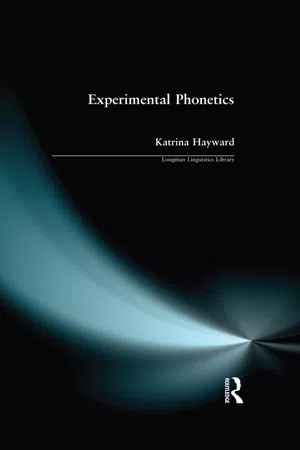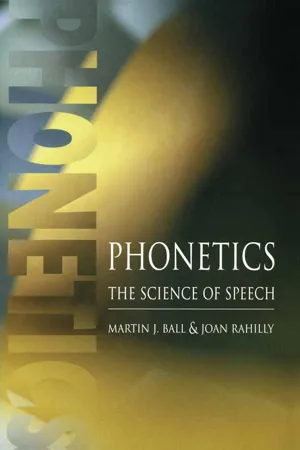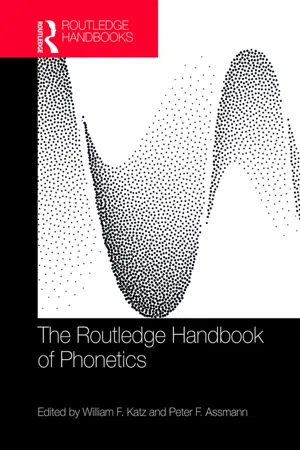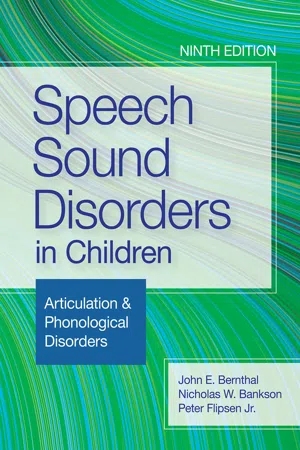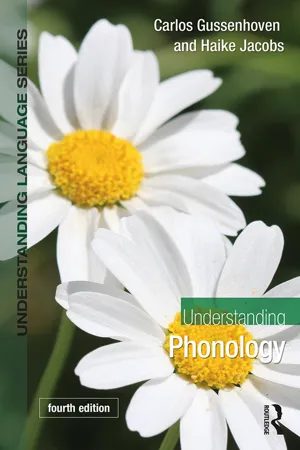Languages & Linguistics
Fricatives
Fricatives are a class of consonant sounds produced by forcing air through a narrow channel in the vocal tract, creating friction. This results in a hissing or buzzing sound. Examples of fricatives in English include the sounds represented by the letters "f," "v," "s," "z," "sh," and "th." Fricatives are characterized by their high degree of turbulence in the airflow.
Written by Perlego with AI-assistance
11 Key excerpts on "Fricatives"
Learn about this page
Index pages curate the most relevant extracts from our library of academic textbooks. They’ve been created using an in-house natural language model (NLM), each adding context and meaning to key research topics.
- eBook - ePub
Patterns in Language and Linguistics
New Perspectives on a Ubiquitous Concept
- Beatrix Busse, Ruth Moehlig-Falke, Beatrix Busse, Ruth Moehlig-Falke(Authors)
- 2019(Publication Date)
- De Gruyter Mouton(Publisher)
Fricatives, by definition, require continuous airflow. Voicing, to the contrary, requires the oscillation of the vocal folds, i.e. a periodic opening and closing of the folds. To do that, the folds need to be brought close enough to build up air pressure below the larynx, causing the fold tissues to vibrate in a wave-like motion. Furthermore, to keep the pressure below the larynx as high as possible, the pressure inside the mouth needs to be lowered. However, air pressure needs to be higher in the mouth in order to produce friction so that a fricative, instead of a stop, is created. Smith (2009) suggests that balancing the two contradictory requirements can be problematic since narrowing the closure in the mouth to increase oral pressure for frication can easily result in a stop production. The flip side of this, that is relaxing the vocal tract to lower the pressure, would however result in an approximant. These phonetic scenarios suggest that the production of voicing in Fricatives arguably involves sub-optimal configurations. Indeed, voiced Fricatives are known to be less loud and crucially shorter in frication noise than their voiceless counterparts, perhaps as a result of the optimization of these contradictory forces. They are approximately 40 percent shorter than their voiceless counterparts, according to Lavoie’s (2009) own measurements. We also have to bear in mind another phonetic property associated to voicing and frication, which will be crucial to understanding the distribution of voiced dental Fricatives: Cole and Cooper (1975) find that listeners make use of temporal information to process voicing distinctions in Fricatives such that shortening fricative duration suffices to establish a change in percept from voiceless to voiced (cf - eBook - ePub
- Martin J. Ball, Nicole Muller(Authors)
- 2014(Publication Date)
- Psychology Press(Publisher)
Because the gap that is left is so small, the escaping air is put under increasing pressure as it is forced through the air channel. This results in turbulent airflow, and this turbulence is perceived by listeners as having a hissy, or noisy quality (see Fig. 6.3). Phoneticians likened the production of these sounds to the creation of friction when two surfaces rub against each other, so the teim fricative came into being. The noise component of these sounds is sometimes termed frication, or friction. FIG 6.3. Fricative production (solid line: passive articulator; dotted line: active articulator; arrows: airflow; black arrow: turbulent airflow). FIG 6.4. Fricative channel shapes. The exact quality of the frication differs from sound to sound depending partly on which articulators are involved, but also on the shape and size of the narrow channel through which the escaping air is forced. For example, there are several different Fricatives that are made with the tip and/or blade of the tongue up against the back of the front teeth or the alveolar ridge. Other sounds made at these areas, for example, stops, are very similar to each other. However, with Fricatives it is possible to alter the air channel as well as the exact location of the articulation. Let us compare the fricative sounds at the beginning of the English words “sin” and “shin.” The [s] in “sin” is made with the tongue tip on the alveolar ridge, and with a very narrow air channel, such that the resultant sound is termed a grooved fricative. On the other hand, the [ʃ] in “shin” is produced with the tip and blade of the tongue against the back part of the alveolar ridge, but with a flatter, broader channel shape, and the resultant sound is called a slit fricative. We can also look at the fricative at the beginning of the English word “thin,” which is articulated between the tongue tip and the back of the front upper front teeth (or for many speakers, between the upper and lower front teeth) - eBook - ePub
Relevant Acoustic Phonetics of L2 English
Focus on Intelligibility
- Ettien Koffi(Author)
- 2021(Publication Date)
- CRC Press(Publisher)
There is unanimity in the L2 English community that the Fricatives [θ] and [ð] are extremely difficult to acquire. For this reason, various proposals have been made. One recent proposal that is not without controversy was made in Jenkins (2000:138). She proposed that [θ] be taught as [f], and [ð] as [v]. This chapter is not a critique of Jenkins’ position, but rather an assessment of the intelligibility of [s, z, f, v, θ, ð, ʃ, h] on the basis of 3350 tokens produced by 67 L2 talkers whose native languages are Arabic, Japanese, Korean, Mandarin, Slavic, Somali, and Spanish To this end, these segments are analyzed instrumentally and compared and contrasted with identical Fricatives produced by 10 native speakers of GAE._______________32 Maddieson (1984:41) does not include /h/ in the fricative count. Many phoneticians do not include [h] in their study of GAE Fricatives because it does not qualify as a fricative in a strict definitional sense. There is no constriction when it is produced; as air molecules flow freely without meeting any obstacle. It is, however, included in the study of Fricatives in this chapter because the ways in which it is produced or not produced can interfere with intelligibility.6.1 Definitions and Overview of English Fricatives
Fricatives are defined as speech sounds produced when airwaves encounter an obstacle. The obstacle is caused when one or several of the movable articulators and the immovable articulators come so close together as to narrow the passage of air molecules. The movable articulators are the lower lip, the tip of the tongue, the blade of the tongue, the root of the tongue, and the uvula. The immovable articulators are the upper lip, the teeth, the alveolar ridge, the hard palate, the velum, and the pharyngeal wall. In the production of stops, a moveable articulator and an immovable articulator seal off, albeit momentarily, outgoing (or incoming) air molecules. However, in the production of Fricatives, there is no complete obstruction. The articulators simply come into a very close proximity to each other so as to narrow the air passage by varying degrees. As a result of these synchronized articulatory gestures, a hissing sound is made when Fricatives are produced. It has been noted that Fricatives call for the type of articulatory precision not commonly found in the production of other consonants. Ladefoged and Maddieson (1996:137) observe that “a variation of one millimeter in the position of the target for the crucial part of the vocal tract makes a great difference. There has to be a very precisely shaped channel for a turbulent airstream to be produced.” Table 6-1 - eBook - ePub
Experimental Phonetics
An Introduction
- Katrina Hayward(Author)
- 2014(Publication Date)
- Routledge(Publisher)
3 transition. When these are investigated independently, the relationship between the acoustic signal and the corresponding speech sound (phoneme) appears to be highly variable. Alternative approaches have focussed on the overall spectrum in the neighbourhood of the burst and on changes across the acoustic boundary between a consonant and its adjacent vowel. These have been more successful in identifying characteristics which might serve as invariant cues.A good overview of work on place of articulation up to the early 1980s is Syrdal (1983).7.4 FricativesThe rasping sound associated with fricative consonants is due to turbulent air flow, which occurs when the airstream emerges from the narrow constriction formed by the articulators. Accordingly, fricative consonants are defined acoustically by constriction intervals which are filled with noise rather than with silence. A good example is provided by the spectrogram of English /ʃ/ shown in Figure 7.1 .In the IPA chart, Fricatives are classified using the two dimensions of place of articulation and voicing. It might be expected that each place should be associated with its own characteristic pattern of spectral peaks and valleys, rather as each vowel has its own characteristic formant pattern. The one exception is the glottal fricative [h]. This is because [h] does not involve any special positioning of the vocal organs above the larynx. The peaks and valleys in the spectrum of any particular [h] will generally match those of following or preceding vowels. In the case of intervocalic [h] between vowels which differ in quality, a gradual change in formant structure, linking the preceding and following vowels, is generally observed during the consonantal interval.In addition to spectral shape, Fricatives differ from one another in relative intensity and in the nature of their formant transitions. Relative intensity is particularly important for distinguishing between sibilant and non-sibilant Fricatives; in English, for example, sibilant /s/ and /ʃ/ are clearly more intense than non-sibilant /f/ and /θ/. As regards formant transitions, these are similar in character to transitions for stop consonants, and reflect the movement of the tongue and jaw from the position for the fricative to the position for the following vowel. - eBook - ePub
Phonetics
The Science of Speech
- Martin J Ball, Joan Rahilly(Authors)
- 2014(Publication Date)
- Routledge(Publisher)
However, a division of Fricatives in terms of their sound quality is often encountered, and this includes a wider range of places of articulation. Sibilant Fricatives are those with a higher pitch and greater acoustic energy than non-sibilant Fricatives. Sibilants include [ s, z, ʃ, ʒ,ʂ,ʐ,ɕ,ʑ ] while non-sibilants include [ ɸ, β, f, v, θ,ð,ç,ʝ, x, ɣ, χ, ʁ,ħ, ʕ ]. Phonologists often divide Fricatives into ‘strident’ and ‘non-strident’ (that is to say, greater versus lesser acoustic noise), with [ θ, ð ] in the non-strident group and [ f, v, s, z, ʃ, ʒ ] in the strident group. Phoneticians do not all agree with this last analysis, as it cuts across both the production and perception divisions of slit/grooved and sibilant/non-sibilant described earlier. Lateral Fricatives As we noted in Chapter 3, Fricatives can be pronounced with both central and lateral airflow. The Fricatives we have described up to now have been all central, but both voiced and voiceless alveolar lateral Fricatives are relatively common sounds in natural language. As noted in Chapter 3, a lateral fricative is formed when there is a closure made between the central part of the tongue and the roof of the mouth (e.g. the tip of the tongue and the alveolar ridge), but air is allowed to escape down one or other side of the tongue (and for some speakers both sides of the tongue). However, this lateral gap for the air to flow through is kept narrow, so that the air escapes with turbulence. Lateral Fricatives can be both voiceless and voiced, and may be part of laterally released affricates. They are most common at the alveolar place of articulation, though unofficial symbols exist for both palatal and velar lateral Fricatives (see Table 4.5). Trills and taps ——————————————————— Trills and taps can be considered as varieties of stops, but they have traditionally been listed as separate classes of obstruents - eBook - ePub
- William F. Katz, Peter F. Assmann, William F. Katz, Peter F. Assmann(Authors)
- 2019(Publication Date)
- Routledge(Publisher)
Glide articulations are the class of consonant articulations that are most similar to vowels. Air flows relatively unimpeded in the oral cavity, and indeed most glides are simply a relatively short version of a high vowel. The glide counterpart of the unrounded front (palatal) vowel /i/ is /j/; /w/ is the glide counterpart of the rounded back (velar) vowel /u/; /ɥ/ is the glide counterpart of the rounded front (palatal) vowel /y/; and /ɰ/ is the glide counterpart of the unrounded back (velar) vowel /ɯ/. In many languages, the unrounded glides serve as variants of stop or other manners of articulation at the same place of articulation. For instance, where there is not a complete closure for /g/, the sound may be lenited to [ɣ] or even to [ɰ]. In many languages, a palatal /ɲ/ or /ʎ/ may be realized over time as [j] – that is, the nasal or lateral components of the articulation are not realized.Fricatives
Fricatives are characterized by a critical constriction in the oral cavity. By “critical” it is meant that the constriction creates turbulent airflow, and the resultant spectrum is characterized by noise (i.e., spectral energy is distributed randomly across the frequency range). The exact spectral properties of the fricative are dependent on both the location of the constriction and on the length of the constriction. The primary determiner of spectral characteristics of a fricative is the size of the cavity in front of the constriction. However, although constriction location and constriction length are relevant factors for the other consonant manners of articulation, as discussed earlier, they seem to be all the more critical for Fricatives in ways that are not yet fully understood. Although by far the largest number of symbols in the IPA chart is for the class of Fricatives, the precise articulatory and spectral differences between the various Fricatives, in particular the typologically less common Fricatives, is in need of further study. In this section I will consider some of the salient characteristics of Fricatives, including those in some less well-studied languages.Figure 10.5a shows an example of the glottal fricative /h/ in the word hala - eBook - ePub
- Bruce M. Rowe, Diane P. Levine(Authors)
- 2022(Publication Date)
- Routledge(Publisher)
Fricatives are produced by an incomplete obstruction of the airstream. Instead of the completed obstruction that produces the stops, the airstream is only partially obstructed, creating turbulence (friction) beyond the constriction. The result is a hissing sound similar to the first sound you hear coming from a whistling tea kettle. In English, Fricatives are produced in the following positions: labiodental [f] and [v], dental [θ] and [ð], alveolar [s] and [z], and palatal [š] and [ž]. The first of each set of sounds is voiceless, the second voiced. Unlike stops, it is possible to prolong a fricative sound for as long as you can exhale.Affricates are each, in a sense, two sounds. The affricate starts out as a stop but ends up as a fricative. Notice that in forming the initial and final sound in church, there is a momentary stop followed by a hissing (fricative) sound. The sound is phonetically represented as [č]. The only other affricate in English is [ ǰ ], the initial sound in Jell-O and gin.Liquids are distinguished from the other classes of sounds in that they involve only minimal obstruction of the airstream and friction is not produced. As with affricates, only two liquids, [l] and [r], exist in English. The [l] and [r] are produced in significantly different ways. Articulating the tip of the tongue with the central portion of the alveolar ridge forms the [l] as in limb. This articulation occurs so as not to stop the airstream completely and allows the air to pass along one or both sides of the tongue. Because of this lateral (side) movement of air, the [l] is called a lateral liquid.The [r] sound in English is usually formed by curling the tip of the tongue up behind the alveolar ridge and by bringing the tongue forward and upward toward the alveolar ridge without touching the ridge. Because of the curling of the tongue, such sounds are often called retroflex (retro = back or behind, flex = to bend). The initial sound in Ralph is a liquid retroflex sound.Glides - eBook - ePub
- William F. Katz(Author)
- 2013(Publication Date)
- For Dummies(Publisher)
P roducing speech is a tricky business and the exact way in which consonants are made can result in vast differences in how these sounds are heard. In this chapter, I walk you through some different types of consonant manners (stops, Fricatives, affricates, and approximants), zeroing in on those mouth and throat details that make big perceptual differences in the English language.Stopping Your AirflowStop consonants (sounds made by completely blocking oral airflow) are part of a larger group called obstruents , which are sounds formed by shaping airflow via obstruction (this group also includes Fricatives and affricates). Fricatives are made when air is blown through a space tight enough to cause friction (or hissiness). Affricates are sounds that begin as a stop, then release into a fricative. Refer to Chapters 4 and 5 for more information on these types of sounds. When airflow is completely stopped, several different things can happen:Air can be released into the vocal tract in different ways.Air can flow into different regions when the sound is released.The duration of the closure itself can last for longer or shorter periods.Some of these puzzling mechanics are revealed in the following sections. Huffing and puffing: Aspiration when you need itAspiration is the airy event that takes place just after the burst of the articulators blasting open and before the voicing of the vowel. Aspirated voiceless stop consonants are made with an audible puff of breath. Aspiration, represented by the raised letter “h” ([ʰ - eBook - ePub
Speech Sound Disorders in Children
Articulation & Phonological Disorders
- John E Bernthal, Nicholas W Bankson, Peter Flipsen(Authors)
- 2021(Publication Date)
- Brookes Publishing(Publisher)
/m/ , the labiodentals allow the tongue to assume its position for preceding or following sounds. The jaw tends to close to aid the lower lip in its constricting gesture.Figure 2.16. Vocal tract configuration for /f/ and /v/ . Note labiodental constriction.Interdental SoundsThere are only two interdentals, both Fricatives: the voiceless /θ/ (e.g., thaw) and voiced /δ/ (e.g., the), which are illustrated in Figure 2.17 . The frication noise is generated as air flows through the narrow constriction created by the tongue tip and the edge of the incisors. The weak frication noise is not much different from that for /f/ or /v/ . The weak intensity of these sounds should be remembered in articulation testing, and the clinician should include both visual and auditory information in evaluating this pair of sounds. Jaw position for /θ/ and /δ/ usually is closed to aid the tongue in making its constriction. These sounds may be produced with either an interdental projection of the tongue or tongue contact behind the teeth.Figure 2.17. Vocal tract configuration for /θ/ and /δ/ . Note linguadental (interdental) constriction.Alveolar SoundsThe alveolar place of production is used for two stops: the voiceless /t/ (e.g., too) and the voiced /d/ (e.g., do); a nasal: /n/ (e.g., new); a lateral: /l/ (e.g., Lou); and two Fricatives: the voiceless /s/ (e.g., sue) and the voiced /z/ (e.g., zoo). Not surprisingly, given the frequent and diverse movements of the tongue tip in the alveolar region, motions of the tongue tip are among the fastest articulatory movements. For example, the major closing and release movement for the stops /t/ and /d/ is made within about 50 milliseconds, or a 20th of a second. For /t/ and /d/ , an airtight chamber is created as the tongue tip closes firmly against the alveolar ridge and the sides of the tongue seal against the lateral oral regions. The site of tongue tip closure actually varies to a limited degree with phonetic context. When /t/ or /d/ are produced before the dental Fricatives /θ/ and /δ/ , the stop closure is made in the dental region. This context-dependent modification of alveolar consonant production is termed dentalization and is illustrated for /t/ in Figure 2.18 - eBook - ePub
- Jethro Bithell(Author)
- 2018(Publication Date)
- Routledge(Publisher)
tu? ə].The semi-consonants are sub-members respectively of the phonemes [j] and [w], and they are intermediary between these consonants and the vowels [i] and [u]. The difference between consonant and semi-consonant is that their frictional quality varies; in North Germany they are articulated with more friction than in South Germany. Pronunciation of the semi-consonants is faulty if there is too much friction; the degree of friction is graded by the narrowness of the constriction and the energy of the articulation. Equally faulty is the pronunciation of the consonants [j] and [w] as semi-consonants, that is with too little friction; e.g. of jung as iung [ĭuŋ]. How colloquial pronunciation tends to the change of semi-consonant to fricative consonant can be heard in adjes [adl je s], vulgar for adieu [adĭtø ], or in the historical change of i to j in je<M.H.G. ie (see p. 93).FRICATIVESFricatives are formed when two speech organs approach each other, but without contact, so that the air is expelled through a chink or constriction (Reibeenge). Since there is an opening, though it is a narrow one, Fricatives are sometimes called ‘open consonants’, in contrast with ‘stopped consonants’.For r and l as Fricatives, see p. 133.LABIAL FRICATIVESThe Lippenzähnereibelaute [f] and [v] are formed by friction of the air along the edges of a lip-chink formed, in standard N.G.DENTAL FRICATIVES SIBILANTSSibilants (Zischlaute) are produced by raising the front part of the tongue together with the tip against the hard palate near the upper alveoli and against the upper teeth, here forming a constriction through which the air is forced so energetically that it rubs against its edges, thus producing the hissing which is the characteristic of these sounds.(θ) and [ð]. For the voiceless dental fricative [ð] and the voiced dental fricative [δ] the tip of the tongue is (1) pushed just under the upper front teeth, and the air expelled through a chink made by tip and teeth—in which case we have interdental th (das Zahnrand-th) - eBook - ePub
- Carlos Gussenhoven, Haike Jacobs(Authors)
- 2017(Publication Date)
- Routledge(Publisher)
In the case of obstruents, an acoustic source is actually created at the point of articulation: either a popping sound is produced (for plosives), or friction is produced at that spot (for Fricatives and affricated plosives). The auditory quality of sonorants relies exclusively on the different shapes the vocal tract is given, i.e. on the resulting modifications of the acoustic characteristics of the sound produced by phonation in the larynx.Obstruents are subdivided into plosives (also called stops ), Fricatives and affricates .Plosives
These are formed by creating a complete closure at some point in the speech tract, behind which the air from the lungs is compressed until the closure is abruptly released so that the air explodes outwards. Since the soft palate is raised, the air cannot escape through the nasal cavity. Examples are French voiceless [p t k], as in [pip] ‘pipe’, [tip] ‘type’, [ekip] ‘crew’. Voiced plosives occur in French [bide] ‘bidet’ and [gã] ‘glove’. Plosives have a very brief friction burst when they are released, which is not usually heard as friction but is responsible for the popping quality of plosive releases.Fricatives
These are formed by narrowing the speech tract to such a degree that audible friction is produced when air passes through. English has the voiceless labiodental fricative [f] in fee , the voiceless dental fricative [θ] in thigh , the voiceless alveolar [s] in sigh and the voiceless palatoalveolar [ʃ] in shy. The voiced counterparts [v ð z ӡ] occur in vie, that, zoo and measure , respectively. (At the beginning of the syllable, English [v ð] are frequently pronounced without friction.)Affricates
Affricates are plosives whose release is slow instead of sudden, causing a longer phase of turbulence. The affricates [pf] and [ts] occur in German [ˈpfaifə] ‘pipe’ and [tsait] ‘time’, and the palatoalveolar affricates [tʃ] and [dӡ] occur in English cheer and jeer , respectively.Sonorants
These divide into nasals and approximants .Nasals
For nasals the soft palate is lowered, and the oral cavity is blocked completely at some point. A slow, deliberate pronunciation of morning

